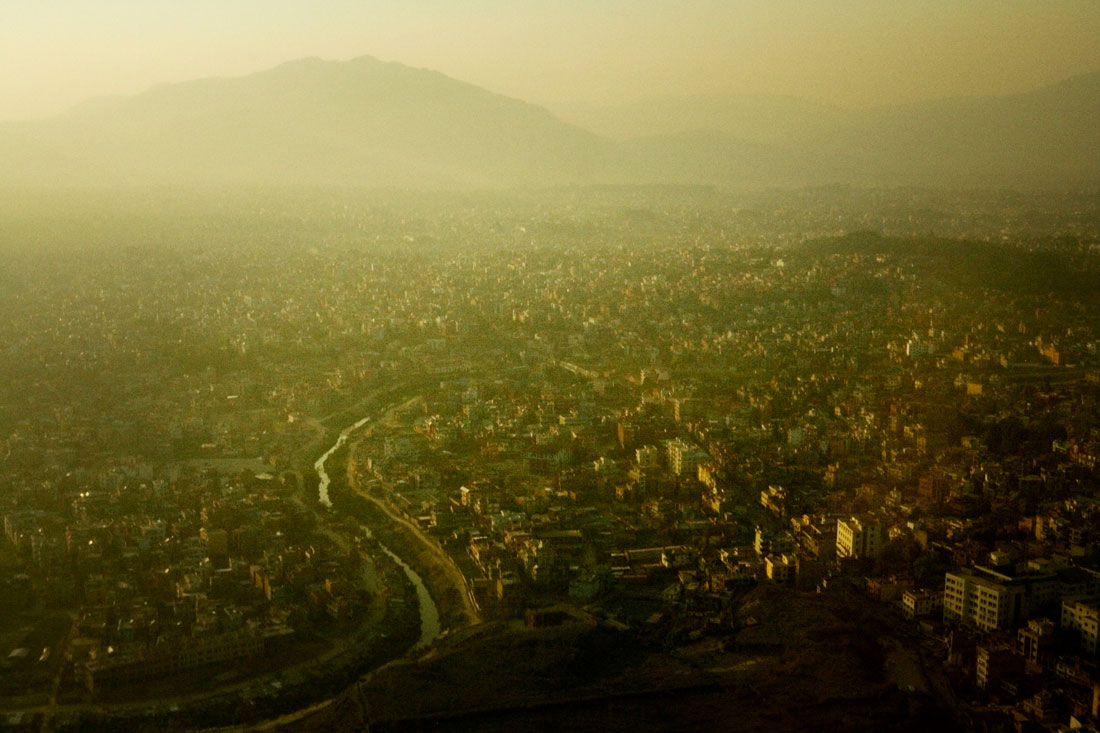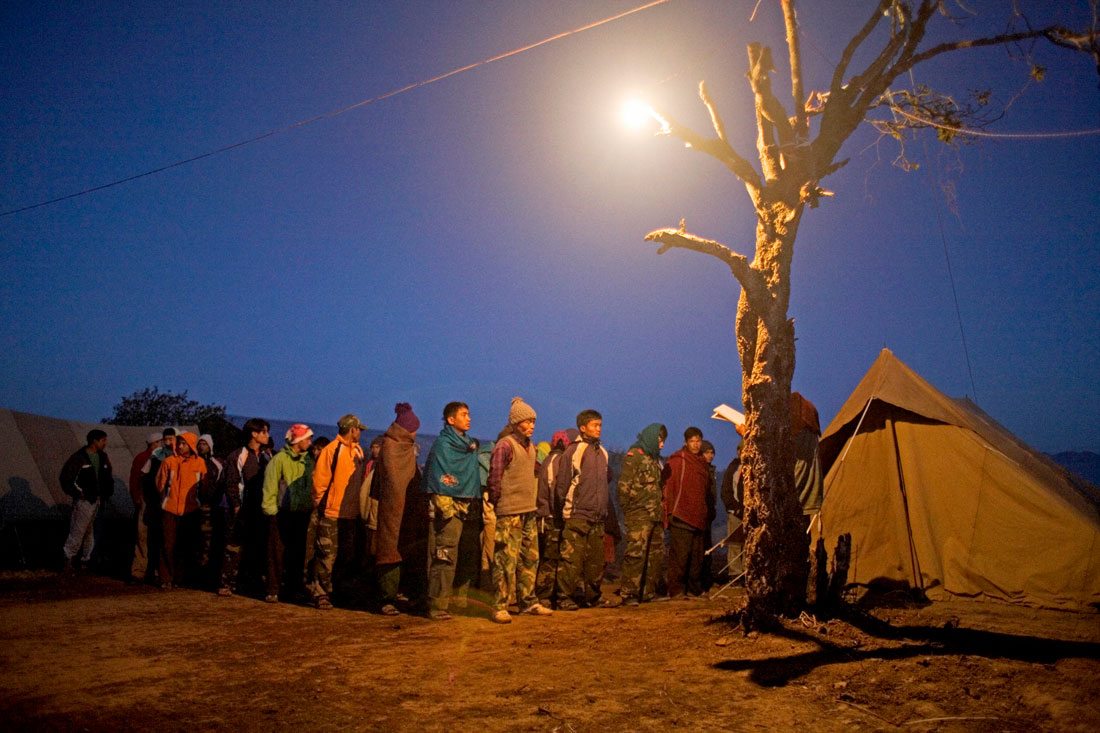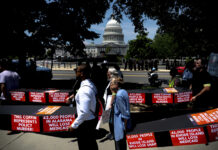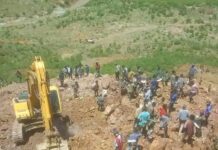
By Douglas Gillison
For years, the US military overlooked the growing scandal of a child’s murder at a US-sponsored training facility, records show.
In 2004, Nepali army officers tortured a schoolgirl so brutally that she died. They buried the body of 15-year-old Maina Sunuwar on the grounds of an American-sponsored training center for international peacekeepers.
Devi Sunuwar, Maina’s mother. Photos by Jonas Bendiksen for Magnum.
For nearly a decade, key American diplomatic and military officials quietly overlooked the fact that the Birendra Peace Operations Training Center — on which the US has lavished millions of dollars — was the scene of the crime, which was carried out on orders from the center’s commanding officer.
But in 2013, that changed. A State Department official flagged a nearly seven-year-old United Nations report documenting the Birendra Center’s role in the killing. The murder’s ties to US support for peacekeeping could no longer be ignored.
Rather than holding the military accountable however, newly released documents show US officials were intent on maintaining an uninterrupted flow of US support for the center, despite the discovery. Defense Department officials and a State Department contractor actively sought to avoid triggering a US law designed to promote accountability for such crimes. They feared the United States would have no choice but to cut off support for the Birendra Center, which trains thousands of the world’s UN peacekeepers each year with Washington’s blessing.
Photo by Igor Ovsyannykov via Unsplash.
American officials in Kathmandu and at US Pacific Command in Hawaii, a regional seat of American military power, argued strenuously against disqualifying the training center under US human rights laws, according to newly released documents obtained by 100Reporters under a Freedom of Information Act request. Instead, Washington persisted in uninterrupted relations with Nepal’s armed forces — responsible for the bulk of killings and disappearances after a ten-year civil conflict that left 13,000 dead. Nepal went on to become an important US partner in the development of UN peacekeeping forces.
In the meantime, Maina Sunuwar’s killers enjoyed years of impunity. US officials failed to use the murder as leverage over a weak local judicial system meant to serve countless families victimized in similar situations.
Mandira Sharma, a founder of the Nepali human rights group Advocacy Forum, told 100Reporters she believed the United States had missed a chance to strengthen the rule of law in her country.
“I very much think that if the US had suspended its support on the grounds of this case, Maina’s family would have got justice long ago,” she said.
With pressure, a chastened Nepali military could have been led to cooperate in this case and many others like it, she contended.
“Lack of rule of law and impunity continues to be the major challenge in protection and promotion of human rights in Nepal,” Sharma said.

The Hit
On the morning of May 21, 2013, an official at the US Embassy in Kathmandu emailed the embassy’s Office of Defense Cooperation, reporting that there had been a “possible hit” on the training center — meaning information that could threaten continued military cooperation.
“Last night Washington sent us the link below,”
said the author, enclosing a link to a 2006 report by UN human rights workers. (The author’s name was withheld from the released records.)
A police post in the heart village of Ghari Gaun, formerly a Maoist stronghold, where there was no police presence. Photo by Jonas Bendiksen for Magnum.
Whereas the embassy had understood the killing occurred
at an army barracks, the report said crucially that it had
taken place at the Birendra Center, according to the message.
“Let me know when you have time to discuss this,”
According to the UN, the Nepali military had attempted to keep secret the findings of a court of inquiry board looking into Maina Sunuwar’s death.
But a report from investigators nevertheless made its way into the hands of the UN Office of the High Commissioner for Human Rights.
According to the UN report which summarized the findings, the inquiry determined that soldiers had taken Maina from her home on February 17, 2004 and delivered her to the training center, where she was tortured for 90 minutes in the presence of seven officers and enlisted men.
The training center’s acting chief, then-Lt. Col. Babi Khatri, ordered that her head be forced into a large pot of water six or seven times and held down for a minute each time, the report said.
Her captors “then administered electric shocks to her wet hands and feet four or five times.” After this, she was blindfolded, handcuffed and held in a training center building.
“She later began vomiting and foaming at the mouth, and died without having received medical treatment,” the report said.
The men then attempted to cover up the killing — firing a bullet into the back of her corpse and burying it on the training center grounds, according to the report.
The commanding officer issued an internal report “stating that Maina Sunuwar had been shot while trying to escape.”
But the inquiry concluded this was a transparent lie, finding instead that “[i]t was indeed as a result of torture inflicted during the course of the interrogation that the death of Maina Sunuwar occurred.”
The killing also represented a deepening cycle of violence and repression in Nepal, with the army killing Maina Sunuwar in an attempt to stifle controversy over the murder and alleged rape of her cousin Reena Rasaili, who had been suspected of supporting the Maoist insurgency just days before Maina’s killing.
For years, the army stonewalled civilian authorities investigating Maina Sunuwar’s disappearance and murder.

Kathmandu, 2007. Photo by Jonas Bendiksen for Magnum.
Alarm over Accountability
In the chain of correspondence that followed, stretching from the embassy in Kathmandu to the Pentagon and State Department, American officials reacted as if they were only learning of the peacekeepers’ involvement in the killing for the first time in 2013. The involvement of officers and facilities at the Birendra Peace Operations Training Center risked invoking a US law known as the Leahy Amendment, which requires the United States to deny assistance to foreign security forces that commit gross violations of human rights.
The records do not make clear how the fact of
the peacekeepers’ involvement could have escaped
American attention for seven years.
For much of this time, it was not State Department practice to screen entire units, such as the Birendra Center, only the precise individuals selected to receive training and equipment — meaning some US background checks might not have considered the Birendra Center as a whole. The policy had changed in 2011.
Just an hour after learning the Birendra Center had been named in the UN report, the head of the US embassy’s Office of Defense Cooperation (ODC) — a position held at the time by US Army Major Dawood Luqman — fired off an “urgent” email to US Pacific Command in Hawaii.
“I don’t need to tell you what a blow it would be,” Luqman wrote, “if BOPTC was blacklisted because of Leahy Vetting.”
Kathmandu. Photo by Simon Steinberger.
“There are 4 individuals implicated in this case and All [sic] were in some way connected to BPOTC,” he added. “This is strong enough evidence, as we have see [sic] recently, to blacklist entire units so the likelihood of this happening to BPOTC are [sic] high.”
The timing of the hit was particularly bad: Just the month before, troops from 24 nations had completed the Shanti Prayas II “capstone” exercise for peacekeepers at the Birendra Center, making a sudden cut-off of aid a particularly painful and embarrassing prospect. Such a cut-off could raise questions about the legality of the just-completed exercises.
Luqman said he and others were working with people responsible for human rights vetting “to provide arguments for why BPOTC should not be blacklisted.”
“Our arguments center around the fact that three of the four individuals implicated in the case were court-martialed and punished and are now out of the army,” wrote Luqman.
He acknowledged, however, that,
“[t]he Human rights organizations do not consider the punishments severe enough.”
Indeed, according to the UN Office of High Commissioner for Human Rights, or OHCHR, a court-martial had sentenced three of the men involved to just six months’ imprisonment for negligence in disposing of Maina’s body.
They were together ordered to pay the equivalent of just under $1,100 in compensation to the family.
“In the view of OHCHR-Nepal, justice has not been done,”
the agency said in a statement in 2006, because the outcome placed no blame for the killing and was unlikely to deter future abuses.
Luqman told Pacific Command headquarters that he and others would argue that the center was not a unit with fixed personnel assigned to it — and so it would be unfair to bar the whole center and not just the men responsible.
“This argument has not been particularly successful in the recent past as we are barred from engaging entire battalions even though the individuals have long since departed and the [human rights] violations occurred nearly a decade ago,” he wrote.
Luqman did not respond to a request for comment from 100Reporters.
In Hawaii, Scott A. Weidie, a program manager in charge of peacekeeping training efforts at US Pacific Command, leapt to the defense of the training center.
Nepal had trained thousands of peacekeepers at the center and supplied 95,000 troops to 37 different UN missions over 53 years, sacrificing the lives of 59 personnel members in the process, he wrote back at 9:24 pm Hawaiian time on May 20th, 2013.
“[I]t is evident that the personnel assigned there are some of the most qualified peacekeeping trainers in any peacekeeping training center in the whole region, and possibly the world,” he wrote, pointing out that his views were his own and not an official US position.
“This is not the School of the Americas of the Cold War educating dictators with torture as part of the curriculum nor is it a center where human rights abuses got out of hand like at Abu Ghraib prison,” wrote Weidie.
As a result of US engagement, training at the Birendra Center included human rights instruction, he added, saying that blacklisting the center and not the individuals responsible would be “completely misguided.”
“I wish I could provide a stronger and more coherent argument but I am not a human rights scholar or lawyer. But I do know when I see and hear something wrong,” wrote Weidie.
“The torture and murder of [redacted] was wrong. The fact that justice was not adequately served and the family of the victims [sic] cannot have justice is wrong,” he wrote.
“But to blacklist a model peacekeeping training center is also wrong. It is the height of hypocrisy for the US to blacklist such a training center while many actions during the US War on Terrorism are so openly questioned,” wrote Weidie.
“I also agree it would have a major negative impact on US security cooperation activities in Nepal.”
Weidie passed the email chain on to officials at the Office of the Undersecretary of Defense for Policy at the Pentagon and the Bureau of Political-Military Affairs at the State Department in Washington.
At the State Department, a private contractor, who was assigned to peacekeeping matters from the Anglo-American defense giant BAE Systems Inc, cast a jaded eye on the affair, accusing the US Embassy in Kathmandu of excessive human rights stringency.
Kathmandu. Photo by Rachel H.
“In the past year alone, they have enhanced their internal criteria several times,” wrote the contractor, whose name was withheld. He marked his message, “[j]ust between you and me (no distro please).”
“We’re not sure if this is an individual on a mission […] or he could be getting pressure from above in the Embassy Country Team.”
The contractor asked that other officials “try to reason” with the embassy’s point of contact on vetting.
Weidie replied: “I will discreetly talk to ODC when I see him in a couple of weeks in Bangkok,” and ask if the embassy were being simply diligent in applying following procedure or exceeding it.
“They are going way beyond the requirement,” the contractor replied, despite the fact that it was Washington, and not the embassy, which had made the six-and-a-half-year-old discovery in this case.
“Tread very softly here, though. Many sensitivities.”
There was reason to believe, however, that the Nepali military was sensitive to action on human rights from Washington and could have responded to American demands for accountability — such as threatening to cut off military aid.
In 2004, the year of Maina’s murder, the US Congress had put specific human rights conditions on military assistance to Nepal, requiring the US State and Defense departments to monitor the local government’s efforts to bring perpetrators to justice.
Immediately after the legislation was adopted, the Nepali army chief of staff visited both the Supreme Court and National Human Rights Commission, promising cooperation with both institutions — Human Rights Watch called the move “unprecedented.”
“There are signs that the US is beginning to monitor the behavior of the armed forces more carefully, but it is unclear how sustained this has been or will be,” the organization said in a 2005 report.

Early morning roll call at a cantonment camp for Maoist guerillas at the village of Dahaban in the district of Rolpa. Photo by Jonas Bendiksen for Magnum.
Acting Late . . . or Never
American officials’ failure to consider the military’s killing of Maina as a possible bar to cooperation under the Leahy law occurred despite mounting public protest over the killing, media coverage and international outrage.
Vermont Senator Patrick Leahy — the original sponsor of the human rights vetting laws whose words are closely followed by State Department officials — had risen twice to the Senate floor in 2009 to denounce Maina Sunuwar’s killing by Nepali soldiers.
He noted in December that the army had attempted a cover-up to make it look “as though she had been shot while trying to escape, and then buried her body at the center.”
The failure to act also flew in the face of extensive published reporting from human rights workers, who say they were in regular contact with the US Embassy in Kathmandu about the case.
Richard Bennett, who served as the Nepal representative for the UN Office of High Commissioner for Human Rights from 2007 to 2010, said the suggestion that American officials were unaware the killing happened at the center beggared belief.
“I find it inconceivable,” he said.
Bennett told 100Reporters that the killing had received extensive mention in annual US State Department reports on human rights in Nepal and that embassy officials appeared keen to prevent US military aid from reaching human rights violators.
Indeed, a classified 2009 diplomatic cable published by WikiLeaks showed Bennett and acting US Chargé d’Affaires Jeffrey A. Moon had agreed to press Nepali authorities on investigating the Maina Sunuwar case.
Sunset in Kathmandu. Photo by Success Dhamala via Unsplash. Kathmandu
It also showed the embassy was aware of the fact that UN officials had reviewed a Nepal Army “investigation file” on the murder.
“I think the US Embassy must have known this already in 2004,” said Sharma of Advocacy Forum.
Her organization had interviewed a person tortured at the Birendra Center who confirmed that Maina Sunuwar had been taken there, she said.
“AF shared this information to the UN and the US embassy,” she told 100Reporters.
But a State Department spokesperson confirmed to 100Reporters that, as a result of the 2004 Maina Sunuwar case, US officials had reviewed the Birendra Center’s eligibility under the Leahy laws only in 2013.
“In light of the courts-martial of the perpetrators of the gross violations of human rights, and other actions taken by the Nepali government, we determined that assistance could continue,” the spokesperson said.
“In 2016, as part of the normal vetting process, we determined that the BPOTC met the standard of a fundamentally different unit from the one that had committed a gross violation of human rights in 2004.
“There had been complete turnover in BPOTC’s personnel, its mission had changed and since then none of its personnel have been implicated in any other gross violations of human rights.”
In March of this year, the United States again staged peacekeeping exercises at the Birendra Center, inviting troops from 34 nations to participate.
The following month, 13 years after the murder, a civilian court in Nepal finally sentenced three of the killers to life in prison — in absentia.
The case marked the first time a civilian court had ever convicted army personnel for a killing committed during the conflict, even though it had been over for a decade, according to The Kathmandu Post.
But it was unclear whether any of the men would ever serve their sentences.
The court also acquitted Maj. Niranjan Basnet, finding he was not directly involved in the killing. Amnesty International called on prosecutors to appeal.
In 2009, the United Nations had expelled Basnet from a UN peacekeeping mission because he had been charged in the case in 2007.
In May, Maina Sunuwar’s mother Devi appealed to the public to call on Nepal’s Attorney General to pursue the case against Maj. Basnet. She lamented the fact that the convicts were not in custody and 13 years on no one had been punished.
“Two months onwards and there is still no sign that the authorities will arrest them,” she said.
If the officers have their way, they will never face punishment, despite guilty verdicts after all these years. Last month, the three petitioned the court to overturn their convictions.








[…] post Protected: Eyes Averted <small class="subtitle">Emails Show U.S. Officials Secretly … appeared first on 100 […]